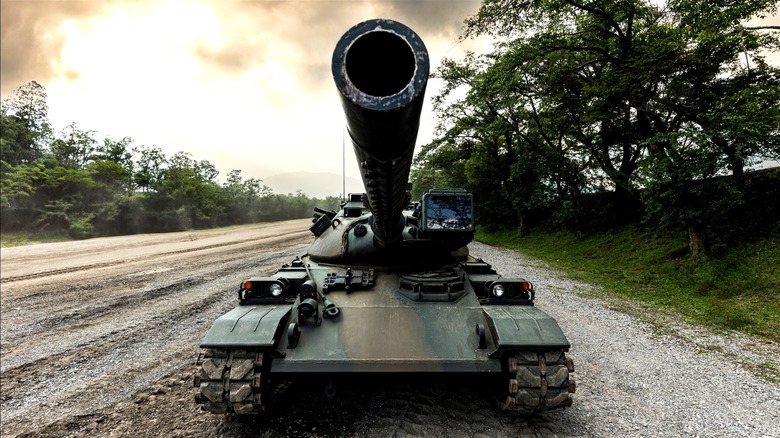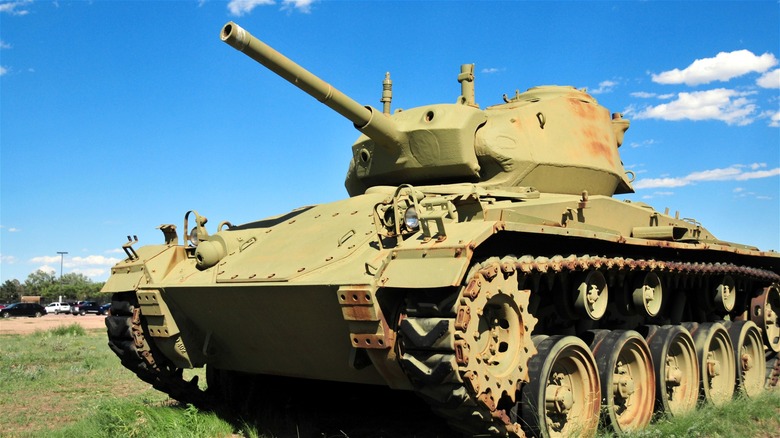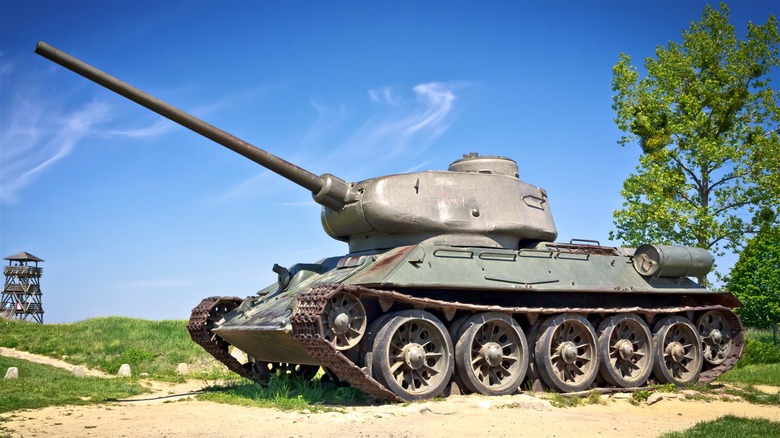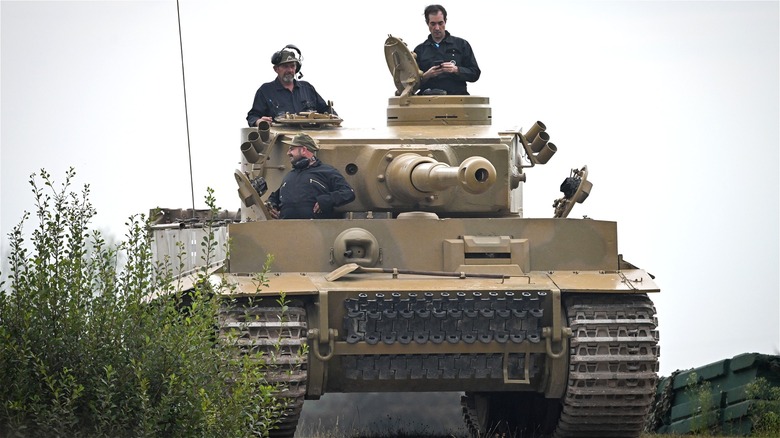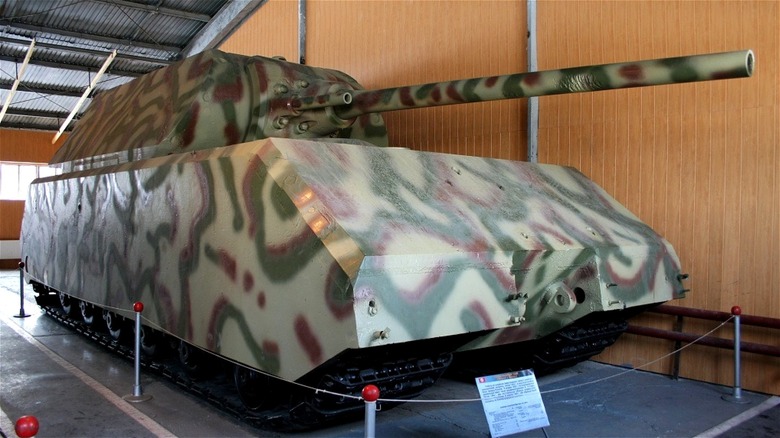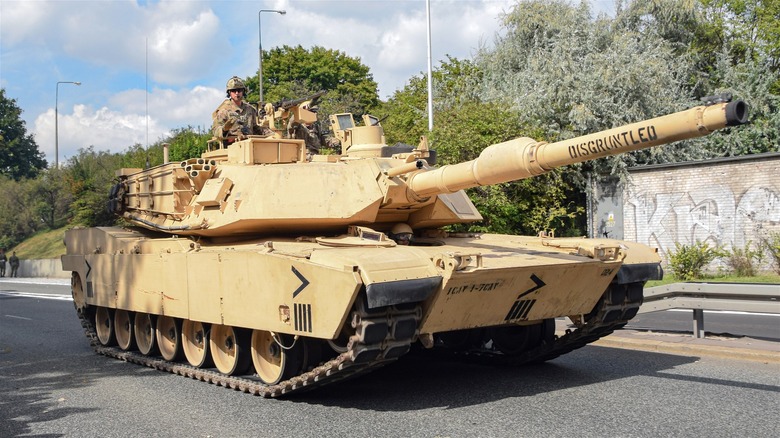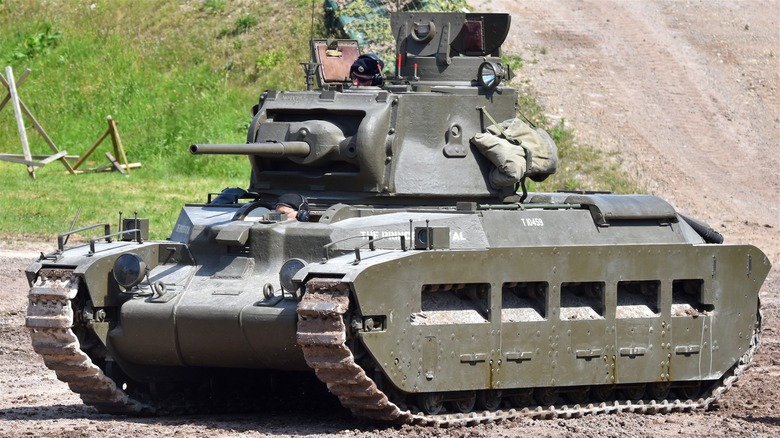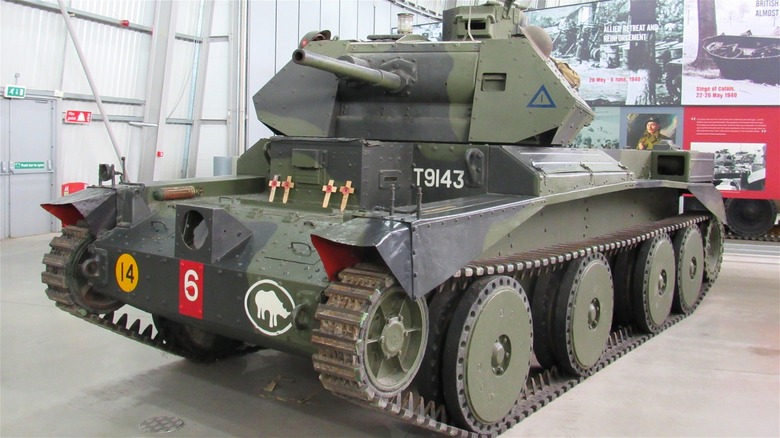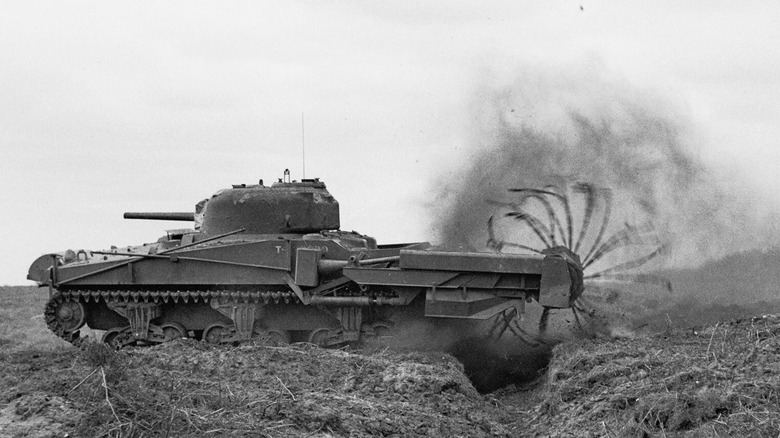Every Major Type Of Battle Tank Explained
Tanks have been a feature of warfare since September 15, 1916, when a British Mk. I heavy tank lurched toward German positions at the Battle of Flers Courcelette, during the Somme offensive of World War I. The Mk. I was an unwieldy beast, but the military vehicle changed the course of history.
During the interwar period, authorities in Britain, France, Russia, Germany, and the United States developed numerous tank design philosophies and strategies. When the Second World War broke out in September 1939, the warring nations had an arsenal of tank classes to draw upon, namely light tanks, medium tanks, heavy tanks, infantry tanks, and cruiser tanks.
Each class saw victory and defeat, but when Axis forces capitulated in 1945, it was clear to military specialists that, generally speaking, the future of the tank lay in a consolidated "main battle tank" style. From the mud-churning fury of the Mk. I to the streamlined innovation of the M1 Abrams, here is every major tank class, explained.
Light Tank
Widely considered the smallest tank class, light tanks emphasize speed and agility rather than armor and brute force. The French created the class during the First World War with the Renault FT-17, a 7-ton vehicle that placed a crew at the front, a four-cylinder engine in the back, and a gun within a fully rotating turret. This became the standard format for tanks of all weight classes.
French designers referred to the FT-17 not as a light tank but as a "mosquito tank." The idea was that large formations of FT-17s would swarm the enemy, overwhelming them with speed, numbers, and cannon and machine gun fire.
Imitations followed through the interwar period and by the Second World War, the light tank class came of age with the American M24, British Mk IV, German Panzer I, Japanese Type 95 Ha-Go, French Renault R35, and Soviet T-26.
In the latter half of the 20th century, the United States and other NATO armies phased out light tanks and other classes, streamlining their fleets into main battle tanks such as the M1 Abrams, the Challenger 1, and the Leopard I. However, China and Russia remained committed to the class, producing the Type 15 and 2S25 Sprut-SD, respectively.
These days, light tanks are making something of a comeback in the West, too. In 2023, the U.S. Army unveiled the M-10 Booker, a 42-ton vehicle referred to as both a "combat vehicle" and a light tank.
Medium Tank
A largely historical designation placed between the light and heavy classes, medium tanks dominated the Second World War on all sides, owing to a well-rounded combination of armor, firepower, speed, and easier production.
Germany built 8,800 Panzer VIs, which may have been less intimidating than the larger Panther and Tiger tanks, but proved an invaluable workhorse with robust, all-around capabilities. On the Allied side was the M4 Sherman, another capable medium tank that was cheap, fast, well-armored, well-armed, and utterly omnipresent (incidentally, the M4 Sherman proved effective long after the Second World War). Then there was the Soviet T-34 — the most important tank of the war. The vehicle was crudely made, but unfussy production methods allowed the Soviets to produce approximately 84,000 T-34s and swarm the enemy across the Eastern Front.
During the Cold War, medium tanks, like light tanks and other classes, were subsumed into the main battle tank philosophy. However, the term "medium tank" may still be used to refer to tanks that weigh around 20 to 50 tons, such as the Russian T-90, which weighs 50.7 tons, and the T-80, which weighs 42.6 tons.
Heavy Tank
Tank history begins with the British Mk. I, a heavy tank. It weighed 28.4 tons, which would place it firmly in the medium tank category by the standards of the Second World War, but the Mk. I was undoubtedly a massive, lumbering beast when it arrived at the Battle of Flers-Courcelette. Germany responded with the A7V, an even larger vehicle at 30 to 33 tons. Like the British Mk. I, the A7V was designed to break battle lines and overpower enemy positions.
During the interwar period, further heavy tanks emerged, like the British A1E1 Independent, the American M6, and the Soviet T-35. However, they were produced in very limited numbers, and often merely prototypes. Only the Tiger I and Tiger II tanks made a notable impact in the Second World War.
Both Tigers were infamous for their thick armor, powerful 88mm guns, and fearsome military record. On October 18th, 1943, a single Tiger destroyed 18 Russian tanks. The following year, Tigers under the command of Michael Wittman destroyed 25 British tanks, 14 half-tracks, and 14 Bren-gun carriers during the Battle of Villers Bocage. However, the tanks were also difficult to produce and operate, and couldn't make up for the massive number of T-34 and M4 Sherman medium tanks.
The production of heavy tanks such as the T-10, IS-3, M103, and the Conqueror continued early into the Cold War. However, the heavy tank class was subsumed by the main battle tank, much like medium and light tanks.
Super-heavy Tank
Super-heavy tanks are relics of history that pushed the boundaries of weight, size, armor, and firepower. Among the first examples was the French Char 2C, a 70-ton beast designed during the First World War that was 34 feet long, 10 feet wide, and over 13 feet high. Authorities planned to make 300 Char 2Cs for a 1919 offensive, but the war ended before then. 10 tanks were upgraded during the interwar period, but they never saw action because, during the Battle of France in 1940, the Luftwaffe destroyed their railway transport, nullifying their threat.
Other European powers made even larger contributions to this tank class. The British TOG II* weighed 80 tons and wielded a 17-pounder armament, developed in 1940 by "The Old Gang," which gave the tank its acronymic name. This gang consisted of First World War veterans who assumed there would be another static front with Germany. However, the German blitzkrieg demonstrated this was a new, mobile conflict, and that the TOG II* was far too large to be effective. And yet, it wasn't the largest tank of the war. Not even close.
In 1944, Germany produced the Panzer VIII Maus, the largest military tank ever built. 12 feet high, 12 feet wide, and 33 feet long, the Maus weighed an incredible 207 tons. Its armor ranged from 50mm to 220mm thick and in the turret was a 128mm gun that could destroy any Allied vehicle at great distance — not that it ever saw combat.
[ Featured Image by Superewer via Wikimedia Commons | Cropped and scaled | CC BY-SA 4.0 ]
Main Battle Tank
Robust, powerful, and generally weighing from 40 to 70 tons, main battle tanks trace their history to the Tripartite conference in 1957, when American, British, and Canadian authorities agreed to adopt the concept of a universal battle tank, following the example set by the British Centurion, the world's first main battle tank.
Entering service in 1946, the Centurion learned from the lessons of the Second World War — namely, the ineffectiveness of the infantry and cruiser tank classes. These classes were designed to work together, but neither had the firepower to be effective.
The solution was to make one composite class — the universal tank, or the main battle tank. In 1961, the United States unveiled the M60, its first main battle tank. With a 750 bhp engine, 10-inch armor, and a 105mm gun, the tank was so good it remained in service for 60 years, until the M1 Abrams surpassed it in the 1990s.
The M1 Abrams was America's response to the Soviet T-80 main battle tank — it represented a big evolution in tank design, and proved its mettle in the Gulf War, destroying dozens of Iraqi tanks in what Captain H.R. McMaster described as "a five-kilometer-wide swath of destruction." The war concluded with five American tank losses and 186 Iraqi tank losses. Main battle tanks continue to be a major force, with all major militaries developing their own, such as the Russian T-90, the British Challenger II, the German Leopard, and the Chinese Type 99.
Infantry Tank
The infantry tank concept emerged in England and France during the interwar period and it drew, inevitably, from the lessons of the First World War. The British Mk. I, though considered a heavy tank, had the qualities of what would be called an infantry tank, for it served to protect the infantry and act as an arrowhead for them to group behind and push through no man's land.
In 1935, British authorities envisioned a tank much smaller than the Mk. I but with heavy armor and a powertrain capable of slow, infantry speeds. By 1936, engineers realized this vision with the Matilda Mk. I and in 1937, the Mk. II. The latter tank saw combat during the Battle of France, impressing the enemy with its thick, impervious armor. When Hitler read reports of 37mm rounds bouncing off the Matilda's 78mm armor, he commissioned the program that would result in the formidable Tiger tank, with its infamous 88mm armament.
The Matilda Mk. II served throughout the war with a mixed reputation. Its thick armor was effective for a time during the North Africa campaign when it was nicknamed "Queen of the Desert." However, it fell victim to 88mm artillery ambushes and was dogged by its slow speed and unreliable, overheating mechanics.
[ Featured Image by Alan Wilson via Wikimedia Commons | Cropped and scaled | CC BY-SA 4.0 ]
Cruiser Tank
During the interwar period, Britain sought to produce fast, nimble tanks that could smash through enemy lines and damage communications, artillery, munitions, and anything else of military value. The first example of this class was the 1937 A10 Cruiser Mk. I, a 12-ton tank with cannon and machine guns that was capable of 25 mph.
Numerous successors followed, such as the Mk. V Covenanter, Mk. VI Crusader, and the Mk. VII Cavalier. Thousands of these tanks were produced during the war, but none of them made quite the impression of the Mk. VIII Cromwell. This 27-ton vehicle was armed with a 6-pound cannon, two Besa light machine guns, and a 600-hp engine capable of 45 mph. Its armor was thinner than some may have liked, but the Cromwell's balance of speed and firepower caused tank historian David Fletcher to describe it as "quite an effective little weapon."
Still, the Cromwell and the cruiser class were not effective enough. Crews appreciated the Cromwell's speed but lamented its lack of armor and firepower when faced with the German Tiger and Panther tanks. These shortcomings would be addressed in Britain's shift to the universal tank class, of which the Centurion was the first example.
[ Featured Image by Makizox via Wikimedia Commons | Cropped and scaled | CC BY-SA 4.0 ]
Specialist Tank
Numerous vehicles fall under the specialist tank class, including bridge tanks such as the M60 AVLB, which can launch a 60-foot bridge suitable for troops, vehicles, and materiel, and amphibious tanks like the Soviet PT-76, a 15-ton light tank that can navigate water, albeit at only 6 mph.
Some of the most distinctive specialist tanks emerged during the invasion of Normandy, codenamed Operation Overlord. Engineers led by Percy Hobart developed a fleet of specialist tanks derived from Churchill and Sherman tanks that became known as "Hobart's Funnies."
The fiercest "funny" was the Churchill Crocodile, which was a regular Churchill heavy tank fitted with a devastating flamethrower with a range of 150 yards. There was also the Churchill AVRE, which was modified to carry important terrain equipment, such as fascines, which were large bundles of brushwood sticks that acted as stepping stones when dropped into tank ditches, allowing the AVRE and other tanks to cross. AVREs also came with "bobbins," huge rolls of canvas cloth that, when unraveled, created dependable roadways for Allied vehicles.
The Sherman Crab, another "funny," was an M4 Sherman sporting a mine flail with a series of metal chains attached to a rotating metal bar. When operated, the flail would detonate any mines in its path, rip through barbed wire, and cause horrific injuries to anyone unfortunate enough to stand in its way.
